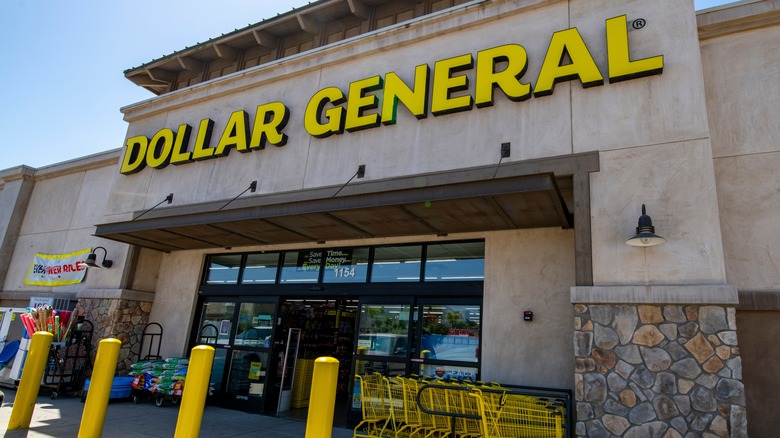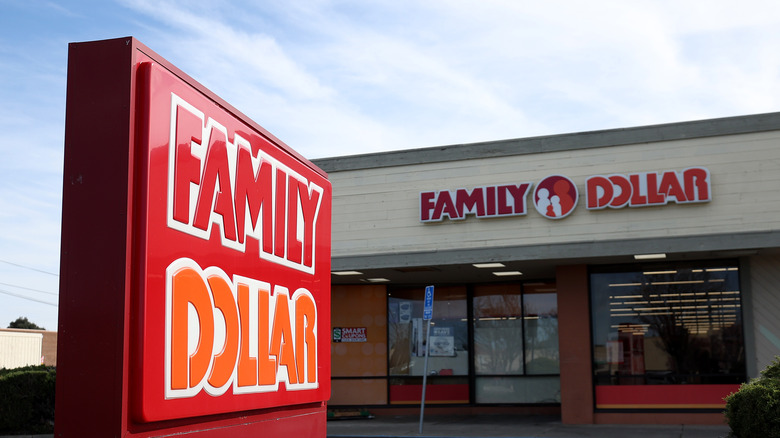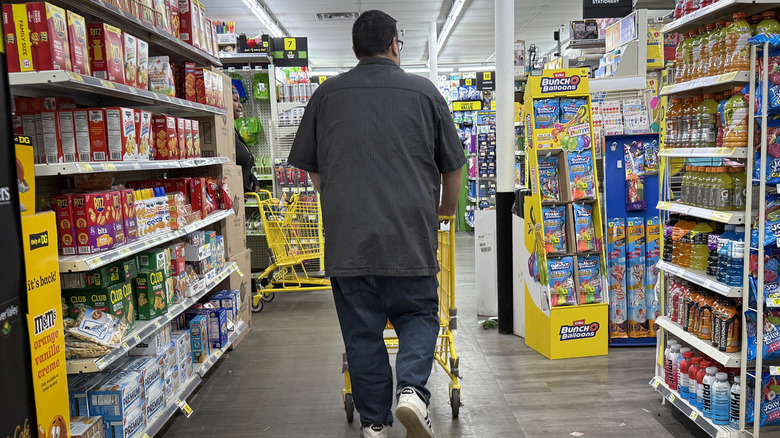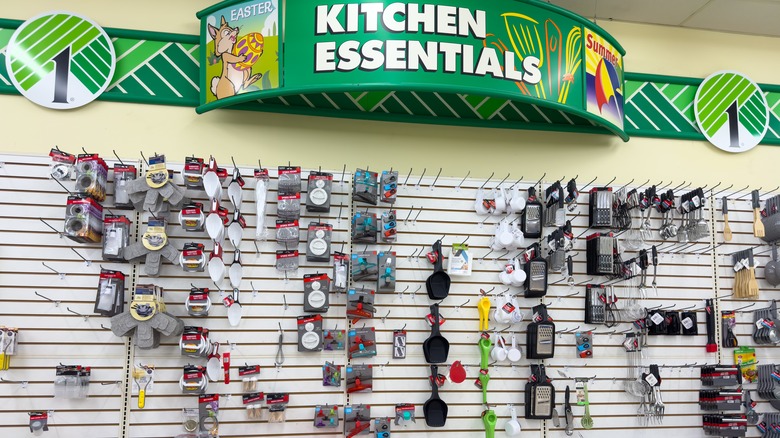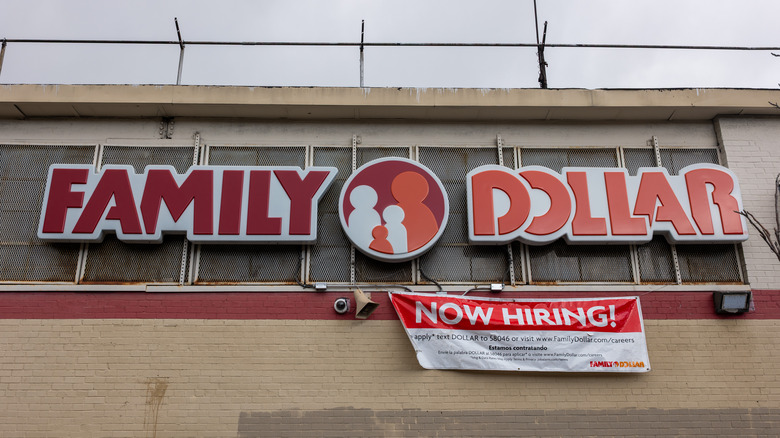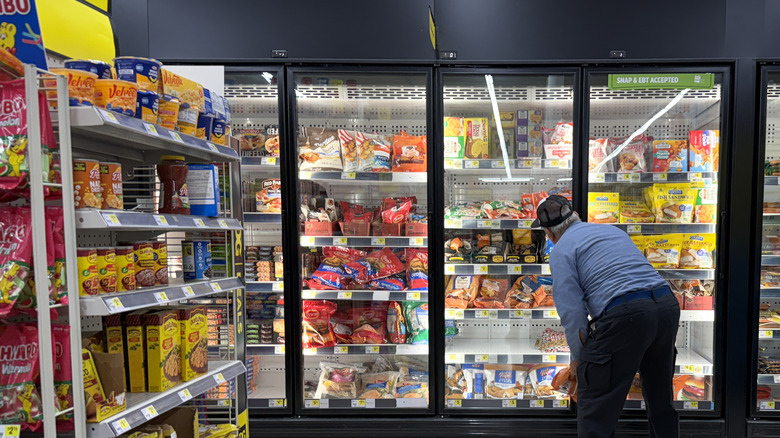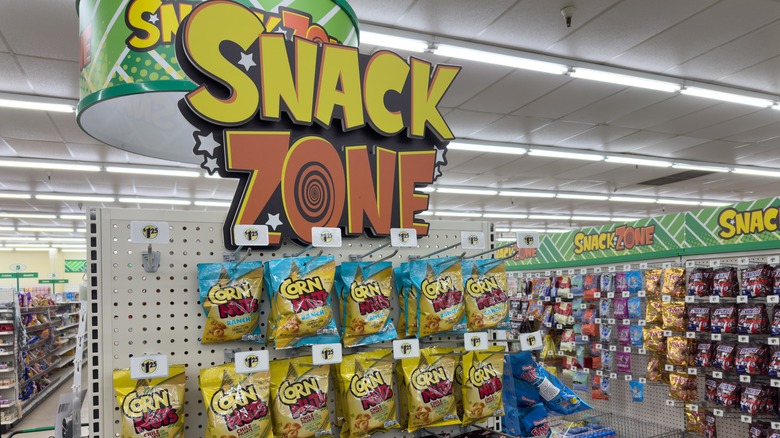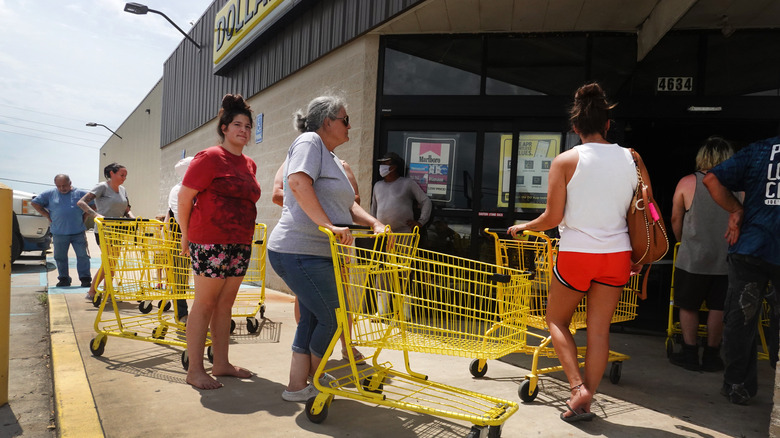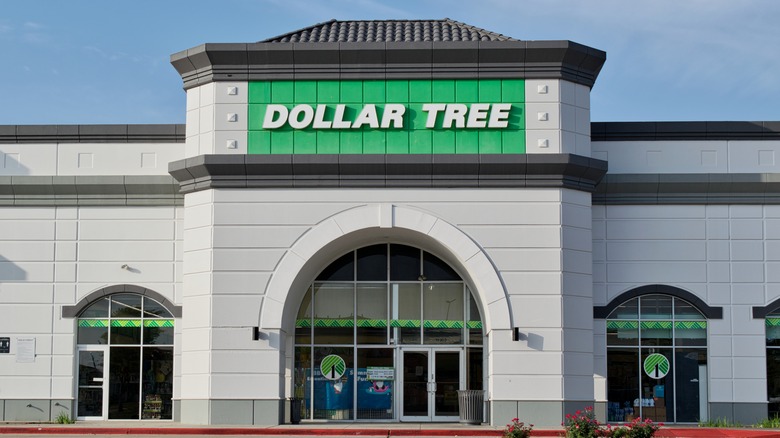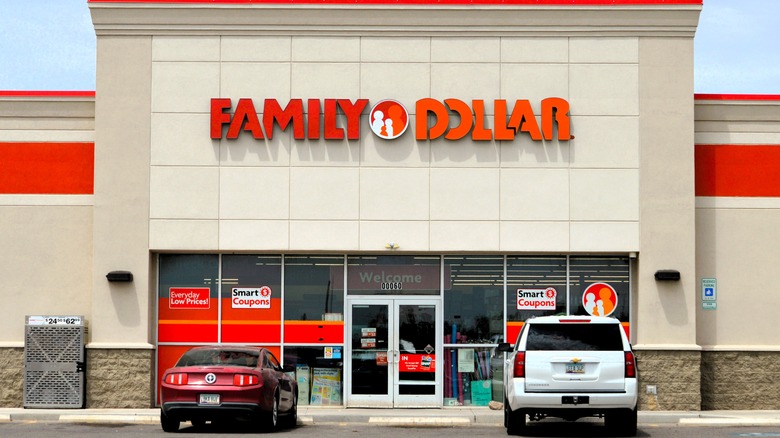This Is How The Dollar Store Stays So Affordable
There was a time when shopping at a dollar store had to be a cloak-and-dagger operation; duck in, duck out, no eye contact, and not a word about it to anyone. It wasn't just highbrow nonsense, either. For years, dollar stores were painted as a blight upon communities, with some research studies even finding that the mere presence of a dollar store in a neighborhood can drag property values down by nearly 20% — yikes.
But with inflation soaring in post-pandemic times, shopping at dollar stores — and pretty much every other heavily discounted retail store — has become pretty standard. Heck, even the rich are shopping at dollar stores now! And unlike some retail giants (looking at you, Publix), dollar stores haven't padded their price tags just because foot traffic's up.
Sure, some items are now priced slightly above the promised dollar, but the markup is barely there if you squint, which is just baffling considering how easily small and big box chains across the country — with the exception of New England's Market Basket, of course — have been swept up by the markup bug. All that just makes you wonder: How are these guys not out of business yet? Below, we'll dig into how the retail giant manages to stay in business with such cutthroat price points.
Low rent small footprint real estate
There's a reason why you might never stumble across a dollar store with the kind of sprawling real estate that's pretty much expected with big box stores like Aldi or Costco. And no, it's not because they can't afford it. Heck, dollar stores sometimes out-earn some big box stores in same-store revenue, especially during economic downturns, when shoppers trade down to save costs.
Dollar General keeps its store footprint at around 7,400 square feet, while Dollar Tree and Family Dollar stores hover around 8,000 and 10,000 square feet. Not only does renting such a tight space cost way less than, say, a 40,000-square-foot supermarket, it also cuts down utility, cooling, maintenance, and cleaning costs, which means less overhead to cover with sales. An 8,000-square-foot lease is far easier to ditch than a sprawling warehouse, which means dollar stores can easily weed out underperforming locations without bleeding red ink, leaving far less hidden losses to cover with sales.
Tight spaces are also great for inventory turnover. While shopping at a big box store like Costco requires quite a bit of planning, it's pretty easy for shoppers to slip in and out of a small footprint store. This ensures a steady flow of foot traffic all day, keeping inventory moving fast enough that stores don't have to raise price points to cover shrink.
Private label brands
Ever wondered why you'll walk into a dollar store and find, say, an automatic spray refill that actually fits the Air Wick dispenser you've got at home selling for a fraction of the name-brand cost? Well, it's this neat trick that's all the rage with retailers: private labeling. How it work's that rather than relying on national brands to supply products, retailers can carry generic versions almost or completely identical to the name-brand variant.
Like Costco with Kirkland Signature or Walmart with Great Value, dollar stores also have their own lineups: Clover Valley (groceries), Comfort Bay (home goods), Chestnut Hill (pantry staples) — all of which mirror name-brand products in the same categories. But unlike name-brands, private label doppelgängers bypass pricey frills like marketing, fancy packaging, and national advertising, which gives the store a much wider profit margin to work with. And while retailers stuck selling national brands are essentially at the mercy of name-brand price points, retailers with private labels can set their own. And with far less overhead, there's a lot more wiggle room on price.
Private labels also give retailers a lot more control over the supply chain. They can negotiate directly with manufacturers and dictate production processes; basically cutting out name-brand middlemen. This tames production costs, generating savings that can then be passed along to the consumer at retail. Greater supply-chain control also insulates retailers against volatility, so they can keep price points rock-bottom even under inflationary pressure. That's why, while everyone quakes at newly imposed tariffs, big-box chains that lean heavily on in-house brands (hello, Aldi) can still slash prices. And while dollar-store private labels aren't yet on par with Aldi or Costco in scale or reputation, they might just be heading that way. Dollar General's Clover Valley brand, for example, has grown to include over 700 items since its inception in 2023, with 100 rolling out within the first quarter of 2025 alone.
Limited product selection with fast turnover
Long winding aisles and towering shelves brimming with inventory; that's the store layout typical of big box chains like Aldi or Costco. And really, why wouldn't it be? When you've got storage space and price margins that expansive, it's possible to stack your aisles with, say, so many baked goods that you end up donating most of them to charity.
That kind of laissez-faire inventory management system is completely out of the question for dollar stores. When you've got almost no storage space and razor-thin margins, you've got to keep a really tight leash on inventory, make sure products are selling through almost as soon as they come in. Else, you'll have a lot of carryover and end up with almost as much waste as Costco or Trader Joe's, only without the price margins to accommodate it. And even if you somehow manage to escape shrink through waste, you'll have to slash prices to boost sell-through or get comfortable with having almost all your cash tied up holding on to stagnant inventory. Either way, you'll have to pad price points a bit to cover your losses.
That's why, rather than carry 20 variations of the same product, dollar stores will have just one or two. Being frugal with product selection makes sure shoppers aren't spending too much time browsing the aisles. This staves off the kinds of crowds you'd get at a big box store like Costco, which is pretty up there on the list of priorities if you need to keep products moving in an 8,000-square-foot space. Shoppers are also less likely to get decision fatigue and bail without buying anything if all you've got is a single item per category. And as a bonus, you don't need to spend a fortune on manpower or tech to keep your stock in check if you've got just one product per category.
Buying clearout or near-expiration goods
From time to time, you'll walk into a grocery store and find some items sporting brand new, far more enticing price tags. Sure, you probably shouldn't grab junk you don't actually need just because it's on sale; that's just bad logic. But say you do it anyway. Then, rather than stew in regret, you decide to try your hand at entrepreneurship and manage to flip it to an unsuspecting relative for a dollar more. They get the junk, you make a quick buck; everyone wins. Pretty nifty, right?
Well, that's exactly the kind of logic behind those meager dollar store prices. Unlike most retailers, dollar stores steer clear of front-of-cycle goods. Because let's face it, if you're trying to keep price points at — or even under — a buck, you can't afford to pay full wholesale prices. What you need is problem inventory: Near-expiration perishables or slow-moving or outdated non-perishables, returns; products someone's so desperate to offload they'll happily take pennies on the dollar.
And when you've got the kind of foot traffic and inventory turnover that's typical and expected of a dollar store, there's very minimal risk to buying products nearing the end of their life. Plus, you'll be offering shoppers familiar brands or perfectly passable produce at rock-bottom prices, so sell-through will not be much of a problem. And sure, a lot of clearance items might be faulty or have minor to severe quality issues, which would be a problem for a typical retailer, but isn't quite so massive a liability for a dollar store. After all, when you've got stores clustered in low-rent areas, you're pretty much guaranteed a customer base that values price advantage over quality.
Minimal staffing
Ever walked into a dollar store and had the sneaking suspicion that nobody works there? Well, it wasn't just your imagination running wild. Unlike wholesale giants like Trader Joe's, which has built a reputation on friendly employees guiding you through every step of the shopping experience, dollar stores run on an incredibly thin staffing model. Sure, you'll spot a couple of employees flitting around at intervals, but they'll be too busy to be of much actual help.
There are a couple of reasons why dollar stores are so scarcely staffed. One's that they don't actually need much staffing. As opposed to the long stretches of unlabeled aisles you'd find at a Costco, the smaller, no-frills store layout typical of a dollar store is much easier for staff to stock, which makes it much easier to run on a skeleton crew.
The other is that they can't afford to prioritize staffing. Employees might make shopping more pleasant, but they don't come cheap; and with labor costs climbing practically by the day, you can't have a customer-oriented workforce and still have razor-thin margins. That's why dollar stores pay such aggressively low wages that scientists have linked dollar store presence to increased poverty and unemployment. And also why they were so quick to jump on the self check-out bandwagon, with Dollar General rolling it out chain-wide by the end of 2022. There was promise that staffing would get a bump after self-checkout proved too brutal on the bottom line due to theft and tech errors, but DG just reassigned the same stretched-thin employees back to manning registers.
Selling products cheaply in small quantities
Yet another reason things are a lot cheaper at dollar stores is, well, because they're a lot smaller. At big box chains like Costco and Aldi, you'll save money hauling home everyday items in sometimes egregiously jumbo sizes. Dollar stores take the complete opposite route to affordability: mini-sizing. The trick to it is that there's a lot more wiggle room with price margins if you divvy up a regular-sized product within an inch of its life. Mini-sizing also keeps transaction costs low, which is ideal when you're operating in a neighborhood populated with low-budget buyers. Smaller-sized products also move pretty quickly since shoppers might have to pick up multiple packages at once or keep returning for more. This means that dollar stores are less likely to have inventory sitting around on the shelves for long stretches, which staves off shrink due to spoilage and, thereby, helps keep margins low.
The catch is: While big box stores almost always deliver on cost savings, dollar store affordability is more or less illusory. Despite the meager price point, many dollar store finds are actually more expensive ounce for ounce compared to regular-sized products. That said, shoppers aren't necessarily getting the short end of the stick with dollar store finds. Bulk buying's pretty wasteful, as anybody who's ever bought spices and herbs in bulk from Costco will tell you. You're not likely to get that kind of waste with dollar store buys, though, since the packaging basically encourages buying only what you need. There's also the fact that bulk buying isn't always financially feasible for some shoppers, so having the option of buying items in small quantities allows shoppers to stretch a small budget across many essential products.
Rotating Inventory
Ever walked into a grocery store only to find some of your favorite buys inexplicably missing from the shelves? Well, that kind of phenomenon is pretty much the norm at dollar stores. What's strange is that, rather than the outrage or mild sulking it might inspire among typical retail clientele, the fact that dollar stores almost constantly switch up their inventory is actually thrilling for shoppers; so much so that dollar stores rely on it to keep their price points low.
Why? Well, just imagine discovering a one-of-a-kind kitchen appliance or even a novelty snack while shopping for canned soup. It's just the thing to transform an otherwise mundane grocery run into a lively anecdote. Combine that wow factor with the fact that everything is priced at or under $1, and you've basically created an impulse-buying haven. After all, you're far more likely to toss things into your cart without a second thought if (A) they barely make a dent in your budget and (B) you know for certain you'll never see them again. And what do you do when you find a store that consistently stocks rare finds? You keep coming back, of course. This kind of treasure-hunt experience is exactly what dollar stores count on to keep inventory moving and foot traffic up. And if products are basically flying off the shelves, then there's really no need to charge more.
High store footprint spread out across the country
Shopping at a big-box store is sometimes such a hassle. You have to drive there, battle the ever-present crowds, drive back; it's just all too much! You don't get that kind of preemptive exhaustion with a dollar-store run, though. That's because there's likely one — or even two — lurking just a few blocks from where you live.
When you've got that kind of store volume, it's very possible to charge rock bottom prices without risking going out of business. For one, the saturation means that you'll get a lot more foot traffic. Even if shoppers only toss a couple of small items into their baskets per visit, the sheer number of visits is enough to keep sales volumes steady. The dense network also guarantees a broad customer base. If there's a store around the corner from everyone, then everyone's a potential customer. And if everyone's a customer, then you're less likely to have inventory sitting around unsold.
There's also very minimal competition with such a dense network of stores. Part of it's because dollar stores can venture into spaces that big box stores like Walmart and Costco wouldn't even dream of. Right off the highway, in strip malls, in a small rural town; pretty much anywhere can scrounge up that kind of space. Dollar store rock bottom prices also push out local grocery stores, so much so that dollar store expansion plans are sometimes met with uproar from communities wishing to keep their mom and pop grocery stores in business. By undercutting the competition with location, high store footprint, and pricing, dollar stores basically establish a de-facto monopoly of sorts, so there's no need to hike prices just to keep the lights on.
Importing in bulk
Finding a dependable wholesale vendor is a foolproof way to stretch your grocery budget. Sure, you might end up spending more in aggregate, but on a per-unit basis, it's basically savings heaven. This nifty savings trick has come in pretty handy for dollar stores, as well. Except, instead of a six-pack of muffins, dollar stores purchase tons of merchandise.
And while you'd typically turn to a wholesale giant like Costco when you need to bulk up on everything from frozen baked goods to tamales or even gourmet cheese, dollar stores set their sights a lot further than that; specifically, overseas markets where labor and manufacturing are cheaper. Dollar Tree imports an estimated 40% of its goods from China, per Investing.com, bringing to port about 90,000 40-foot containers annually. Dollar General, on the other hand, relies so heavily on global imports that it even has a procurement arm in Hong Kong to oversee its global supply chain.
By sourcing goods directly from factories overseas, dollar stores can score huge discounts on products that would typically attract premium wholesale prices locally. The sheer volume of imports also gives them tremendous negotiating power with suppliers, which helps trim costs even further. It also helps that dollar stores maintain a firm grip on supply chain logistics, which helps keep product acquisition costs low. All of that makes it possible to move each unit for a buck or under without bleeding profits.
Pricing
When all else fails, dollar stores fall back on a tried-and-true and incredibly obvious strategy: pricing. Think of it like a self-fulfilling system: Selling things for a dollar is exactly what keeps things selling for a dollar. Since this pricing is so baked into dollar store operations, they're not likely to stock anything unless they can sell it for under, at, or a little over a dollar. And because dollar stores don't have to remain consistent with inventory, they can basically pick up and ditch suppliers at will, which gives them a lot of leverage in negotiations. It's also possible to run a very lean operation if everything is priced at or under a dollar. Without a complex pricing structure, you don't need as many employees for stock management, so you don't have as much overhead to stave off with sales.
Rock-bottom price tags are also great for keeping sales volumes and foot traffic up. Shoppers are more likely to buy things on impulse if they believe they're getting them at a huge discount. The satisfaction of scoring a deal also creates shopping momentum, so shoppers are likely to keep browsing the aisles and dropping things into their carts if everything's priced cheap. Centering your entire brand identity on rock-bottom prices is also great for retaining customers. If shoppers know they can turn to you when their budgets are stretched thin, you're almost inflation-proof, so there's no need to raise prices even during harsh economic times.

